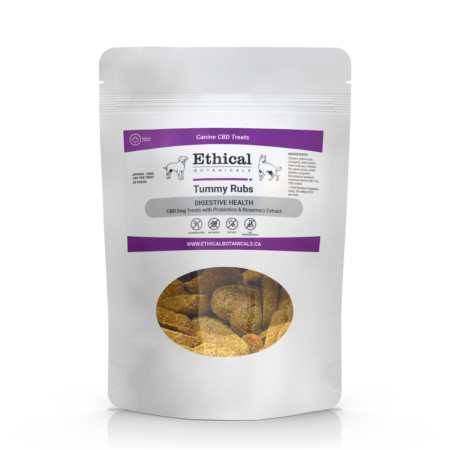Dogs feel pain just as people do, and they have endocannabinoid systems that respond to CBD oil, just as humans do. Though dogs can’t say “ouch!” they can let us know they’re in pain, and give us the opportunity to find ways to alleviate it. But does CBD oil really work on canine pain?
Studies in humans show that cannabinoids (CBD) can alleviate incidences of anxiety, pain, seizures, muscle spasms, aggression, and neurological disorders. Additionally, the majority of medical studies involving CBD have used animal models, mostly using rats as their subjects. These studies also show promise using CBD for pain and inflammation.
CBD isn’t necessary for healthy pets, although it may offer benefits as a preventative supplement. Since CBD is a medically proven anti-inflammatory, and inflammation is the root of most disease, CBD oil for dogs is becoming an area of interest for veterinary scientists. If you believe the all the testimonials, CBD oil may be of benefit to your dog. If you suspect your pooch is in pain, check for some of these tell-tale signs.
How can I tell if my dog is in pain?
When your dog is in pain, look for physical, behavioral, or movement changes.
You will immediately know that your dog is out of sorts if they keep dropping their heads, or if they walk with a hunched posture, or a limp. Other physical signs of pain include trembling and panting.
Just like people who get cranky when they are in pain, dogs forget their amiable selves when pain affects them. Your dog may suddenly dislike being touched, snap or growl at you, or make other noises, and generally appear restless. Loss of appetite and non-stop licking in particular spots may also be signs of pain.
The surest sign of pain and the easiest to see, is when a dog’s movements are affected. A dog that suffers from painful arthritis or has been injured, may have an obvious limp, walk very slowly, or not at all. You may also notice your dog struggling to get in and out of his bed.
What causes pain in dogs?
Apart from injuries, several painful conditions can afflict dogs.
- Cancer can cause a lot of pain, especially bone cancer, which is often not diagnosed early enough.
- Arthritis, often caused by hip dysplasia in many breeds, can cause your dog a lot of discomfort as she ages. The resulting inflammation in the joints can be extremely painful.
- Dogs also suffer from periodontal disease, which can cause toothache.
- Bladder and ear infections are not uncommon in dogs and can be painful in itself or cause kidney stones that can cause major discomfort.
- Intervertebral disc disease (IVDD) is a painful condition that happens when one or more of the discs that separate the bones of the spine in the back or neck degenerates.
Does science support the use of CBD for pain in dogs?
There is very little scientific data to support the use of CBD to treat dogs. A recent study at Baylor College of Medicine found that CBD may help dogs who suffer from osteoarthritis. In a 4-week study that involved 20 large dogs diagnosed with osteoarthritis, the researchers employed a randomized, double-blind, placebo-controlled method – the most reliable in scientific research.
Following evaluations by veterinarians and owners, the scientists concluded that the dogs that received the highest doses of CBD showed the greatest improvement in their mobility and subsequent quality of life. The study was published in the journal Pain.
 How does CBD oil help with pain?
How does CBD oil help with pain?
CBD oil works by having an effect on the endocannabinoid system (ECS), which all mammals have, including humans.
Scientists discovered the endocannabinoid system (ECS) in the early 1990s while they were researching THC—the cannabinoid famed for getting people high. Both THC and CBD are cannabinoids. Over time, we’ve discovered that the ECS regulates a surprising number of functions and processes in the body, including sleep, mood, appetite, and more.
When interacting with the ECS, CBD binds with receptors where it acts as a retrograde pre-synaptic inhibitor. Effectively, CBD inhibits signaling from overactive neurons, dialing down inflammation and pain. It does this by helping neurons inhibit the release of neurotransmitters at the pre-synapse.
How much CBD oil is right for my dog?
There are very few scientific studies on CBD for dogs and that means there is also no scientific suggestions on safe dosages. Seeing that there are no regulations yet, veterinarians are urging caution when administering CBD to dogs.
Before giving your dog CBD consult your vet first. Many holistic vets support the use of CBD for dogs. If your dog is on prescription medications, it’s absolutely vital you speak to your vet first.
If there is no risk of drug interactions, your vet will likely advise that you start with a very low dosage. Most recommend that you start with a small dosage and slowly increase it depending on the dog’s reaction to the CBD. It’s important to monitor your dog’s reaction once you’ve given them CBD.
Factors that might influence how your dog will react to CBD:
- Your dog’s general health and levels of activity
- Existing ailments and medications he’s taking – consult your vet for possible drug interactions.
- Your dog’s size and weight
When shopping for CBD oil, take note of the potency of the product. CBD oils come in different potencies. Be sure to buy the potency that correlates with your dog’s size – if your dog is large, buy a product for large dogs.
You don’t need a lot. Dogs have myriads of cannabinoid receptors, so a small bottle will last a long time.
How long before it starts working?
The effects might be rather subtle. Observe your pet closely to see if you can notice any changes in mood, behavior, mobility, appetite, sleep, and this will help you determine if CBD is having any effect. If your dog enjoys the results, they’ll likely wag their tail and appear enthusiastic the next time the CBD oil or treat is taken out.
Dog owners usually notice a fairly quick improvement of symptoms when they use CBD for anxiety. Dogs usually seem calmer within 30 minutes.
Not everything improves quickly. Serious and chronic conditions will take longer to improve, just as with humans. It may be weeks before you notice a change in your dog’s general wellbeing.
How do I know what CBD oil to buy?
This is the million-dollar question. There are so many products on the market, it’s hard to separate the wheat from the chaff. Here are a few pointers to help you find a reliable product that will be safe and effective for your dog.

- CBD oil for pets isn’t yet regulated, so watch out for products made by scammers. Remember that Hemp oil or Hemp seed oil, probably contain zero CBD.
- Only buy CBD oil that’s free of toxins.
- Check that the product is made from organically grown hemp.
- Check out the company. Do they use safe processing methods? Watch out for methods that use toxic solvents to extract CBD from plants. Propane, hexane, and butane are toxic.
- Check THC levels. The CBD oil you buy for your dog should ideally contain no THC or at least less than 0.3% THC.
- Check whether the product is a full spectrum or broad-spectrum CBD product. Products containing a range of cannabinoids, and not just CBD, seem to get better results.
- Look for CBD oil products that can show certificates of analysis (COA) for their CBD. These lab-tests should show the quality of the CBD, as well as the safety. No molds, toxins, chemical residues or other contaminants.
If your dog has a chronic condition, especially one related to inflammation, CBD might be worth trying, especially since it is safe and well-tolerated in mammals, is non-toxic, non-addictive, and presents no overdose risk. It may potentially be a safer, healthier alternative to pharmaceutical drugs.



